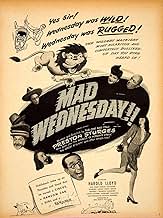An interesting if ultimately unsuccessful combination of two clashing comedy styles (overseen by humorless mogul Howard Hughes no less), this film turned out to be Harold Lloyd's swan-song - and, as such, it ended on a somewhat positive note (even though the film was made during Sturges' period of decline).
It opens with a reprise of the climactic football game from one of Lloyd's greatest successes, THE FRESHMAN (1925), eventually bringing that same character (albeit renamed!) up to date. Still, in the end, the film is more Sturges than Lloyd: even if the star plays one of his trademark roles of a patsy (though not without the occasional display of ingenuity), there is little of the star's characteristic slapstick here. Instead, the comedy is in Sturges' typical frantic (and, mainly, dialogue-driven) style - with which Lloyd isn't entirely comfortable; the film also features Sturges' stock company of character players in full swing. That said, it's climaxed by yet another of the star comedian's thrilling set-pieces which finds him overhanging from a building-ledge - hampered this time around by a myopic Jimmy Conlin and an understandably disgruntled circus lion!
While a disappointing whole (it was re-issued in 1950 in a shortened version renamed MAD Wednesday), the film does contain a number of undeniable gems: his romantic attachment to every female member of one particular family (all of whom happen to work for the same firm over a 20-year period); his first encounter with Conlin, with the two of them exchanging wise sayings (the optimistic Lloyd had kept a handful nailed to the wall behind him at his former workplace) in order to explain their current dejected state-of-mind; and, best of all, the unforgettable scene in which Lloyd takes his first alcoholic beverage (an impromptu concoction by bartender Edgar Kennedy and which he names "The Diddlebock") that invariably provokes an unexpected yet hilarious reaction.




























